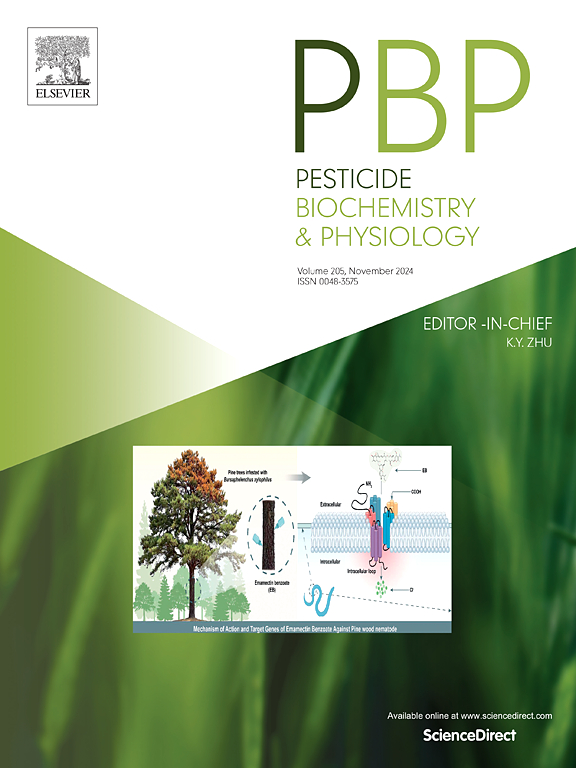Silencing the β-glucan recognition protein enhanced the pathogenicity of Cordyceps fumosorose against Hyphantria cunea Drury larvae
IF 4.2
1区 农林科学
Q2 BIOCHEMISTRY & MOLECULAR BIOLOGY
引用次数: 0
Abstract
The β-glucan recognition protein (βGRP) plays a crucial role in pathogen recognition by insects, thereby activating their innate immunity. However, the immune response of βGRP in Hyphantria cunea Drury (Lepidoptera: Noctuidae), an invasive pest of forests and agriculture, to pathogens remains unclear. In this study, we identified a new isolate of the entomopathogenic fungus Cordyceps fumosorosea. We found C. fumosorosea exhibits significant pathogenicity against H. cunea larvae. Based on the transcriptome, we found that the βGRP genes of H. cunea can be induced to express after infection by C. fumosorosea. βGRP1 is primarily expressed in the fat body and significantly upregulated by 11.23-fold at 12 h post-infection with C. fumosorosea. Besides, molecular docking showed a potential binding interaction between βGRP1 protein and β-1,3-glucans, which is further confirmed by protein-carbohydrate binding assays. Additionally, the knockdown of βGRP1 through RNA interference increases the mortality of H. cunea larvae following C. fumosorosea infection. Taken together, our study underscores the critical role of βGRP1 in the immune response to C. fumosorosea infection and suggests an integrated pest management strategy that combines entomopathogenic fungi with RNA interference technology as an effective approach for controlling H. cunea.

Silencing the β-glucan recognition protein enhanced the pathogenicity of Cordyceps fumosorose against Hyphantria cunea Drury larvae
β-葡聚糖识别蛋白(βGRP)在昆虫对病原体的识别中起着至关重要的作用,从而激活昆虫的先天免疫。然而,作为森林和农业的入侵害虫,βGRP在中国黑蝇(鳞翅目:夜蛾科)中对病原体的免疫反应尚不清楚。在本研究中,我们鉴定了一株新的昆虫病原真菌虫草。我们发现烟孢梭菌对美国血吸虫幼虫具有显著的致病性。通过转录组分析,我们发现被烟孢镰刀菌感染后,美国血吸虫βGRP基因可以被诱导表达。βGRP1主要在脂肪体中表达,在感染烟孢梭菌12小时后显著上调11.23倍。此外,分子对接显示βGRP1蛋白与β-1,3-葡聚糖之间存在潜在的结合相互作用,这一点通过蛋白-碳水化合物结合实验得到进一步证实。此外,通过RNA干扰敲低βGRP1会增加烟孢弧菌感染后的美国血吸虫幼虫死亡率。综上所述,我们的研究强调了βGRP1在对烟孢梭菌感染的免疫应答中的关键作用,并建议将昆虫病原真菌与RNA干扰技术相结合的综合害虫管理策略作为控制烟孢梭菌的有效方法。
本文章由计算机程序翻译,如有差异,请以英文原文为准。
求助全文
约1分钟内获得全文
求助全文
来源期刊
CiteScore
7.00
自引率
8.50%
发文量
238
审稿时长
4.2 months
期刊介绍:
Pesticide Biochemistry and Physiology publishes original scientific articles pertaining to the mode of action of plant protection agents such as insecticides, fungicides, herbicides, and similar compounds, including nonlethal pest control agents, biosynthesis of pheromones, hormones, and plant resistance agents. Manuscripts may include a biochemical, physiological, or molecular study for an understanding of comparative toxicology or selective toxicity of both target and nontarget organisms. Particular interest will be given to studies on the molecular biology of pest control, toxicology, and pesticide resistance.
Research Areas Emphasized Include the Biochemistry and Physiology of:
• Comparative toxicity
• Mode of action
• Pathophysiology
• Plant growth regulators
• Resistance
• Other effects of pesticides on both parasites and hosts.

 求助内容:
求助内容: 应助结果提醒方式:
应助结果提醒方式:


